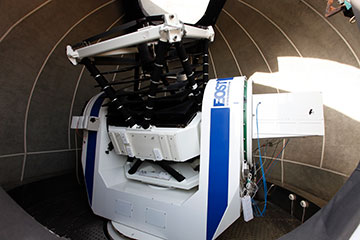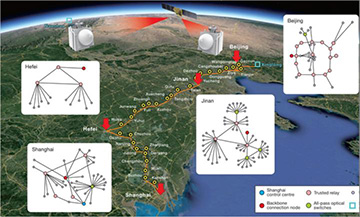The integrated quantum communication network combines over 700 optical fibers on the ground with two ground-to-satellite links to achieve quantum key distribution over a total distance of 4,600 kilometers. [Enlarge image] [Image: University of Science and Technology of China]
Scientists in China have demonstrated what they describe as the world’s first integrated quantum communication network, having used optical fiber to carry out quantum key distribution (QKD) between users in several of the country’s largest cities as well as connect those users via a satellite link to northwestern China.
Although its speed and security still need to be improved, the researchers believe that the network can form the basis for a global communications system whose cryptographic integrity is guaranteed by the laws of quantum mechanics (Nature, doi: 10.1038/s41586-020-03093-8).
Terrestrial and satellite connections
QKD involves encrypting and decrypting messages using keys that are formed from strings of bits encoded via the quantum states of photons. Stealing keys is in principle impossible since any eavesdropper would reveal their presence by changing those quantum states.
The Chinese system consists of four metropolitan networks—in Beijing, Jinan, Hefei and Shanghai—connected to one another via a 2000-km-long fiber backbone that was completed in 2017. That backbone is in turn linked via a space satellite known as Micius—launched into a low-Earth orbit in 2016—to a node in remote Urumqi, some 2600 km west of Beijing.
OSA Fellow Jian-Wei Pan at the University of Science and Technology of China in Hefei and colleagues have shown how the system can be used to link up more than 150 commercial and industrial users through a variety of network topologies. In the process, they have demonstrated a number of technologies needed for quantum communication, such as single-photon detectors and dense wavelength division multiplexing, while also implementing countermeasures against a variety of known attacks that could be launched by quantum hackers.
Practical applications in reach

Researchers in China have linked a fiber optic QKD backbone with a remote node in Nanshan (Urumqi) by using a satellite to link a telescope there with one in Xinglong (Beijing) (pictured). [Image: Sheng-Kai Liao]
These demonstrations have allowed users to make quantum-encrypted audio and video calls with one another as well as exchange emails, faxes and text messages. The researchers calculate that the fiber backbone is able to accommodate at least 13,000 users consuming one 128-bit key per minute, although, as they point out, that does leave the key vulnerable while it is being used. Higher speeds, they say, will be needed for the more secure one-time-pad encryption.
To show how all the elements of the network could be employed to enable a real-world transaction, the People’s Bank of China carried out a Renminbi payment transfer between Urumqi and Beijing. This involved using Micius to generate quantum keys to establish a secure link between ground stations in the two places, relaying those keys across the respective metropolitan networks and then using a standard encryption router to encrypt and transmit the data.
Pan and co-workers argue that these demonstrations show that “quantum technology is sufficiently mature for practical applications.” Expanding the terrestrial and satellite connections, they reckon, could then enable multiple national networks to be hooked up into a single globe-spanning quantum communications system—something that European Union countries are also working on, having agreed in 2019 to develop a continent-wide QKD network over the coming decade.
Integrating twin-field QKD
However, there are still shortcomings that will need to be overcome before such networks can become fully practical. The latest work saw a major boost to QKD between Micius and the ground-station telescopes—with improvements to optical systems, clock rate and the QKD protocol multiplying bit rates by a factor of 40 over previous demonstrations. However, that rate is still severely limited by the fact that the satellite is visible from the ground stations for only a few minutes a day, and even then, only during sunny weather.
The researchers hope to overcome these problems in the future by using a geosynchronous satellite to provide 24-hour coverage. They also plan on developing new technologies for extending the range of QKD on the ground, given that light is severely attenuated in optical fiber over long distances, but quantum bits (unlike classical data) cannot be amplified to compensate. In particular, they intend to integrate what is known as twin-field QKD—a scheme devised by scientists at Toshiba Europe in Cambridge, U.K., that the Chinese group has shown can extend QKD’s range to beyond 500 km.
As Pan and colleagues point out, QKD links could in principle be created over arbitrarily long distances using devices known as quantum repeaters to exploit the phenomenon of entanglement. But these devices are still in the early stages of development, which means that the Chinese network instead relies on what are known as “trusted nodes”—relays for transmitting quantum keys, the security of which is not itself guaranteed by quantum physics.

